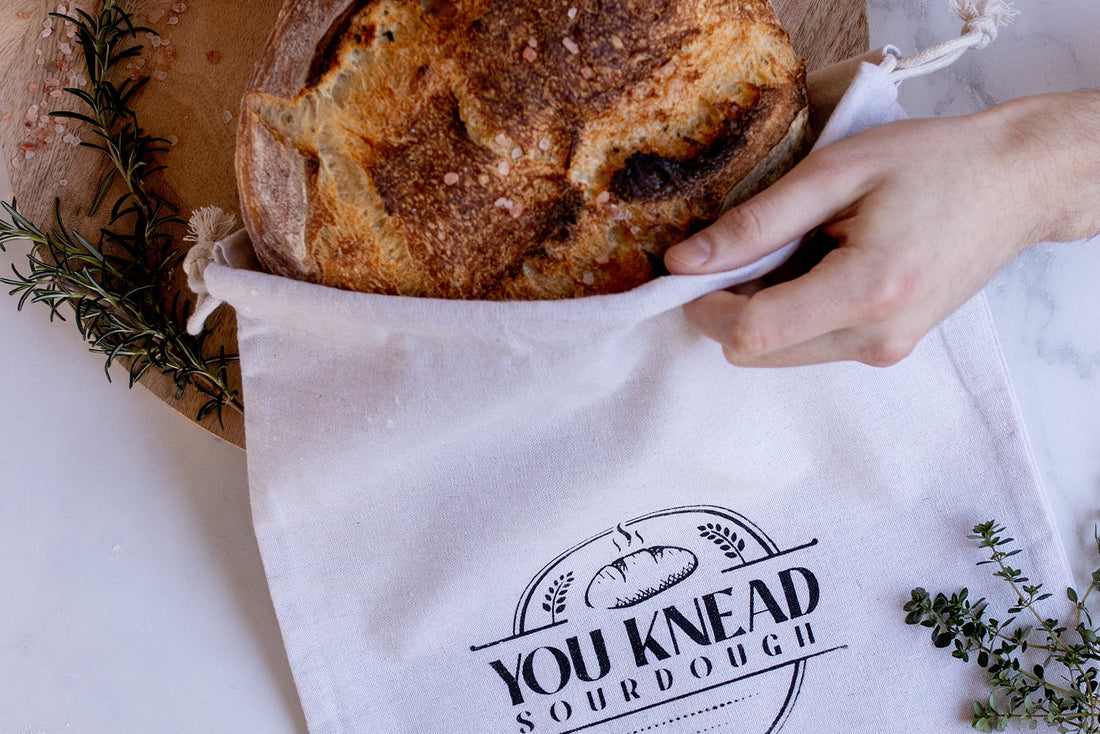Imagine baking the Sistine Chapel of sourdough loaves, only for it to go stale and mould within a few days because you didn’t know how to store it...
This is the reality for many amateur bakers. People pay such close attention to their sourdough recipe and the actual preparation of their sourdough that the storage of it once it’s baked becomes an afterthought.
Others assume that storing bread in the fridge or a plastic bag is the best way to make the most of each loaf, but in actual fact, there are several ways you can keep your sourdough to get the most out of each loaf.
And no, I’m not talking about eating the entire loaf to yourself in one sitting. This will just end in a carb coma and a lot of self loathing, so read on if you want to learn how to make your sourdough bread the extra mile.
Jump to:
- Sourdough Bread Recipe
- The Complete Sourdough Starter Kit
- Oval Banneton with Cloth Liner
- Cotton bread bag
The best ways to store fresh baked sourdough bread

If you’re new to sourdough then you’re probably taking your sourdough storage cues from how your store normal supermarket bread.
Throw that thinking in the trash, along with your discarded sourdough starter, because sourdough bread is not the same. The natural acidity of sourdough bread actually discourages bacteria, which means that it takes longer for it to develop mould than normal yeasted bread.
So, with this in mind, I always recommend storing your freshly-baked sourdough loaf in a cotton bread bag or simply wrap it in a cotton tea towel to allow the bread to ‘breathe’. Then, leave your bread in a cool place, so it can maintain normal moisture levels without encouraging bacteria and mould to grow.
When I say a ‘cool’ place I’m not talking about the fridge. Storing sourdough in the fridge is not ideal, as it’s quite a dry environment and will cause your bread to harden much quicker.
If you’ve ever bought sourdough bread at the supermarket you’ve probably noticed that the loaves are typically stored in paper, rather than a plastic bag. This is because plastic can cause ‘sweating’ if it’s stored in a warm environment, which in turn encourages bacteria.
4 additional ways to store your sourdough
1. Store it unwrapped on the kitchen counter
Homemade sourdough doesn’t contain the preservatives that make store-bought bread last longer, so as long as you don’t slice into your loaf, you can store it unwrapped at room temperature for up to 24 hours. It will start to go stale once you slice into it, so make sure you either eat it or wrap it up after that.
2. Store it in a brown paper bag

Anyone who buys freshly-baked sourdough at Woolies or Coles will notice it comes wrapped in paper. This is because brown paper bags allow the sourdough to breathe, which makes them a simple option for home bakers – just make sure you store your loaf at room temperature for best results.
3. Store your sourdough in the microwave
For many people, bread boxes are a thing of the past, which makes microwaves the next best thing. Modern microwaves are a good option for storing sourdough because they keep air out and maintain a constant temperature to prevent the loaf from going stale and mouldy. Just make sure you don’t accidentally turn the microwave on!
4. Store your loaf whole or sliced in the freezer
I know I said not to store your sourdough in the freezer, but this only applies before it has completely cooled. Once the loaf has cooled you should wrap it tightly in cling wrap (not a plastic bag) and then again in aluminium foil. You can store your loaf like this in the freezer for up to six months before re-baking it again for that freshly-baked experience. But, more on that below.
Why not re-bake your sourdough?
Bet you didn’t know that you could re-bake your sourdough bread. Well, you can.
The best sourdough is served about two to six hours after it has been removed from the oven, but not all of us have the luxury of being able to eat it within that time.
So, this is where re-baking comes in. By re-baking your sourdough, you can relive that fresh out-of-the-oven experience we all strive for when baking our own sourdough.
Be mindful that re-baking your sourdough isn’t just a matter of popping your loaf in the oven for a few minutes and Voilà! In reality, it takes about the same amount of time to re-baked bread as it takes to bake it from scratch – except you do it at a much lower temperature.
You’ll also need to set time aside for the sourdough to cool again, as starches revert to their original state when reheated and will be less digestible until they cool down. So, make sure you give yourself a couple of hours to refresh your bread before you serve it up.
There are a few of the main ways you can store your sourdough to ensure you can enjoy it down to every last crumb. I’d love to hear from you about how you store your sourdough, so make sure you check us out on Instagram and tag us @youkneadsourdough.


